A Mechanistic Overview of Taste Bud Maintenance and Impairment in Cancer Therapies
- PMID: 33693542
- PMCID: PMC8253380
- DOI: 10.1093/chemse/bjab011
A Mechanistic Overview of Taste Bud Maintenance and Impairment in Cancer Therapies
Abstract
Since the early 20th century, progress in cancer therapies has significantly improved disease prognosis. Nonetheless, cancer treatments are often associated with side effects that can negatively affect patient well-being and disrupt the course of treatment. Among the main side effects, taste impairment is associated with depression, malnutrition, and morbid weight loss. Although relatively common, taste disruption associated with cancer therapies remains poorly understood. Here, we review the current knowledge related to the molecular mechanisms underlying taste maintenance and disruption in the context of cancer therapies.
Keywords: Hedgehog signaling; Notch signaling; Wnt signaling; chemotherapy; organoids; radiotherapy.
© The Author(s) 2021. Published by Oxford University Press. All rights reserved. For permissions, please e-mail: journals.permissions@oup.com.
Figures


References
-
- Adler E, Hoon MA, Mueller KL, Chandrashekar J, Ryba NJ, Zuker CS. 2000. A novel family of mammalian taste receptors. Cell. 100(6):693–702. - PubMed
-
- Barbosa da Silva JL, Doty RL, Miyazaki J, Borges R, Pinna FR, Voegels RL, Fornazieri MA. 2019. Gustatory disturbances occur in patients with head and neck cancer who undergo radiotherapy not directed to the oral cavity. Oral Oncol. 95:115–119. - PubMed
Publication types
MeSH terms
Substances
Grants and funding
LinkOut - more resources
Full Text Sources
Other Literature Sources
Medical

